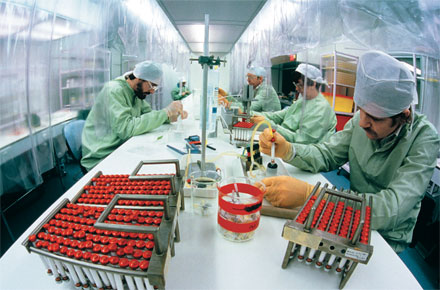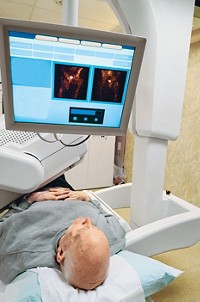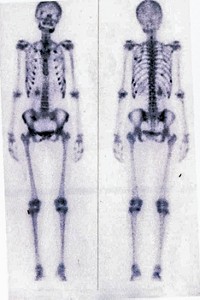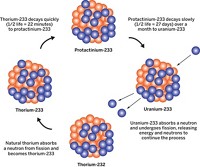Advertisement
Grab your lab coat. Let's get started
Welcome!
Welcome!
Create an account below to get 6 C&EN articles per month, receive newsletters and more - all free.
It seems this is your first time logging in online. Please enter the following information to continue.
As an ACS member you automatically get access to this site. All we need is few more details to create your reading experience.
Not you? Sign in with a different account.
Not you? Sign in with a different account.
ERROR 1
ERROR 1
ERROR 2
ERROR 2
ERROR 2
ERROR 2
ERROR 2
Password and Confirm password must match.
If you have an ACS member number, please enter it here so we can link this account to your membership. (optional)
ERROR 2
ACS values your privacy. By submitting your information, you are gaining access to C&EN and subscribing to our weekly newsletter. We use the information you provide to make your reading experience better, and we will never sell your data to third party members.
Environment
Nuclear Medicine's Conundrum
Another sudden shortage of technetium‑99m calls for long-term solutions
by Ivan Amato
September 7, 2009
| A version of this story appeared in
Volume 87, Issue 36

On May 14, the electricity went dead in parts of eastern Ontario. That triggered the shutdown of the 52-year-old National Research Universal (NRU) reactor at Chalk River. The next day, Atomic Energy of Canada Ltd., the company that operates the facility, reported that “during routine monitoring in the early-morning hours of May 15, a small leak of heavy water was discovered.” That leak meant the reactor would not be starting up again on short order.
It was an ominous revelation for the medical community. The Chalk River reactor is a starting point for a process that supplies at least 50% of the U.S. supply of technetium-99m (the m stands for metastable), the workhorse medical radioisotope for many millions of imaging and diagnostic procedures each year. Because Tc-99m’s chemistry is so versatile, it can be attached to many different tissue-targeting ligands, says Michael M. Graham, president of the Society of Nuclear Medicine and a professor of radiology at the University of Iowa. “We can use it to look at the function of all of these different organ systems,” among them cardiac and gastric tissue, kidney, blood, bone, and brain, he says.
According to the market research firm Bio-Tech Systems, which specializes in medical isotopes, patients in the U.S. received about 23 million doses of diagnostic radiopharmaceuticals annually in the past few years. Of those, about 80% involved labeling agents based on Tc-99m. That amounts to about 50,000 Tc-99m-based procedures being carried out every day in the U.S., a number that increases by several percent every year, according to a report on medical isotope production released in January by the National Academy of Sciences (NAS).
Before the Chalk River reactor shut down, those in the nuclear medicine community already knew that another nuclear reactor central to the Tc-99m supply, the High Flux Reactor, in Petten, the Netherlands, was scheduled for its annual maintenance shutdown in July. So NRU’s shutdown set up the medical isotope market for a double-whammy.
Tc-99m, which has a half-life of about six hours, is a decay product of molybdenum-99, which has a half-life of 67 hours. Chalk River and other reactors devoted to medical isotope production produce Mo-99 from the decay of neutron-bombarded uranium-235 in specially designed targets charged with enriched uranium. These radionuclides’ short half-lives mean that Tc-99m cannot be stockpiled; it must be relentlessly generated and distributed. As the targets come out of the reactors and wend their way through processing and distribution, it is like running across town with a leaking bucket of water trying to serve those who are thirsty. So when reactors shut down, it takes only days for doctors and patients to feel the effects.

In Plainview, N.Y., nuclear pharmacist George Afari of Nuclear Diagnostic Products, says that shipments of “Tc generators”—alumina strips bearing strongly adsorbed Mo-99-bearing molybdate anions (MoO4 2–) that form during acid dissolution of the targets—which nuclear pharmacists in the U.S. can obtain from only two suppliers, have become erratic. “Every week is different now, but we have been down by 30 or 40%,” Afari says. Every day for a week or so, until the radioactivity is too weak to be medically useful, Afari and his coworkers use saline solution to selectively collect Tc-99m in the form of pertechnetate anions (TcO4 –) from the generators’ alumina sorbents. Because of its single charge, TcO4 – clings less tightly to the sorbents than does MoO4 2– and is more readily dislodged by the saline bath. They then prefill syringes with patient- and procedure-tailored doses of Tc-99m-radiolabeled agents for hundreds of hospitals.
This June, at the International Medical Isotope Summit in Toronto, participants released a communiqué aimed at political leaders, regulators, the radioisotope industry, and the medical community with decidedly alarmist language: “This group agreed that the worldwide patient community is facing one of its greatest threats in modern times—the lack of access to a reliable, consistent supply of the most important medical isotopes used in the effective detection and evaluation of patients with cancers, heart and brain diseases, and other disorders.”
The 47-year-old reactor in Petten went back on-line on Aug. 17. But the earliest projected restart for the Chalk River reactor is now the first quarter of 2010, said Atomic Energy of Canada Ltd. President and Chief Executive Officer Hugh MacDiarmid in a video statement on Aug. 25.
“That’s a long-term shutdown,” says William Dawes, vice president of manufacturing and supply chain at Lantheus Medical Imaging, which shares the North American market for Tc-99m generators with Covidien, a firm that sells its imaging products under the Mallinckrodt brand. Dawes’s company has been tapping into arrangements with reactor operators in South Africa and Belgium to help make up some of the near-term shortfall. Covidien has also been diversifying its Mo-99 sourcing.
Even if the shutdown of the Chalk River reactor had lasted only a couple of days and not triggered a shortage, it would have been a stark reminder that the aging reactors now at the front end of the Tc-99m supply chain are on their way to being decommissioned. Chalk River, for one, will operate only until 2016 at best, MacDiarmid said.
And even if these reactors could be operated safely for the next 100 years, there’s another global urgency certain to change the radiopharmaceutical industry.
Perennial concerns about nuclear nonproliferation and terrorism have set into motion legislative actions that most nuclear medicine stakeholders expect will end the production and international transportation of the weapons-grade, highly enriched uranium (HEU) targets from which most Mo-99 is now generated. HEU also serves as the fuel for many reactors.
If passed, the American Medical Isotopes Production Act (H.R. 3276), introduced in July and sponsored by Rep. Edward J. Markey (D-Mass.), would mandate that within seven years of the bill’s passing, there would be a U.S.-produced supply of critical medical isotopes. In addition, the U.S. would stop exporting all HEU. As such, the bill would apply legislative pressure to wean the medical isotope industry from HEU in fuel and targets and replace it with low-enriched uranium (LEU), which cannot be used for making nuclear bombs. South Africa’s nuclear agency just reported that it has successfully converted fuel to LEU at its isotope-making reactor, says Chris G. Whipple, chair of the committee that produced the NAS report and a risk assessment expert with the environmental consultancy firm Environ, in Emeryville, Calif.
The NAS report concludes that “there are no technical barriers to conversion of Mo-99 production from HEU targets to LEU targets. Production using LEU targets is feasible and, in fact, is being carried out” by CNEA, Argentina’s nuclear energy agency. Since the report came out in January, the Australian Nuclear Science & Technology Organisation (ANSTO) has also demonstrated that it can use LEU targets to generate Mo-99 with its Opal reactor, which runs on LEU fuel. In an agreement with Lantheus, ANSTO already has supplied LEU-derived Mo-99 to the company, which has tested and validated it for use in the firm’s workhorse line of Tc-99m generators.
But the ANSTO option would likely supply only a small portion of the U.S. need for Tc-99m in the near term. A higher capacity middle-term solution rests with the Missouri University Research Reactor, in Columbia, Graham says. But this reactor currently lacks the “hot cell” processing facilities required to remotely handle and process irradiated targets—a procedure that involves dissolving the targets in acid and extracting and purifying the isotopes. The Markey bill would authorize the partial funding of such an upgrade to the Missouri reactor, which could be complete within three to five years, Graham says. “This would produce 50% of what the U.S. needs,” he says, essentially the same amount that the Chalk River reactor supplies when it is up and running.
“Within the next two months, we plan to submit a proposal for a processing facility located next to our reactor to the U.S. Department of Energy,” said Robert Duncan, vice chancellor for research at the University of Missouri, in a statement. “The facility would be funded by private and public sources.”
The switchover to LEU-based Mo-99 production “has to happen,” Graham says, but he points out that the conversion could also bring with it some additional baggage. For example, he notes, because LEU targets have something like one-fifth the U-235 atoms that HEU targets have, it will require more material to generate the same Tc-99m supply. And that could translate into more radioactive waste, which, he says, “could exacerbate concern about dirty bombs.”
An even longer term solution, one that the nuclear technology company Babcock & Wilcox is proposing along with Covidien, circumvents the waste issue. In its modular Medical Isotope Production System, B&W proposes to construct wine-barrel-sized “aqueous homogeneous reactors” that run on liquid LEU fuel—aqueous uranyl nitrate, to be specific. Periodically, the Mo-99 produced from the decay of U-235 in the liquid fuel would be extracted, separated, purified, and packaged for shipping to Covidien, which would use it to make Tc-99m generators.
“Because we are skipping a step—no digestion of an LEU or an HEU target—we can be much more efficient,” says S. Robert Cochran, president of B&W’s technical services group. For the same reason, he says, “we don’t generate waste during the process. It is an efficient green technology.”
Other proposals are coming in, too. Whipple tells C&EN that a blue-ribbon panel in Canada that had solicited ideas about making Mo-99 without HEU has received 18 pitches. Among them are proposals in which accelerators take the place of nuclear reactors to generate neutrons for irradiating LEU targets.
All of these are long-term solutions at best, Whipple notes. So before engineers would be able to make them practical, there almost certainly will be additional shortages of Tc-99m.





Join the conversation
Contact the reporter
Submit a Letter to the Editor for publication
Engage with us on Twitter